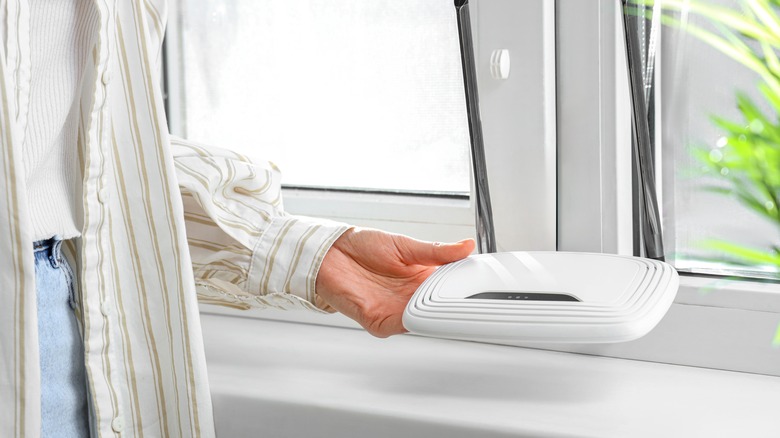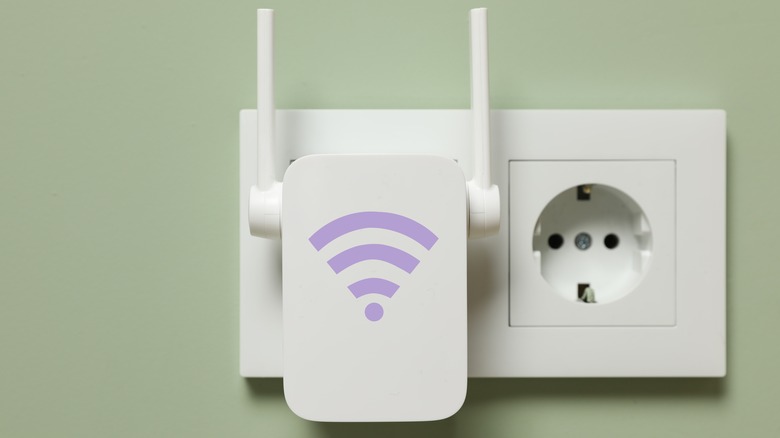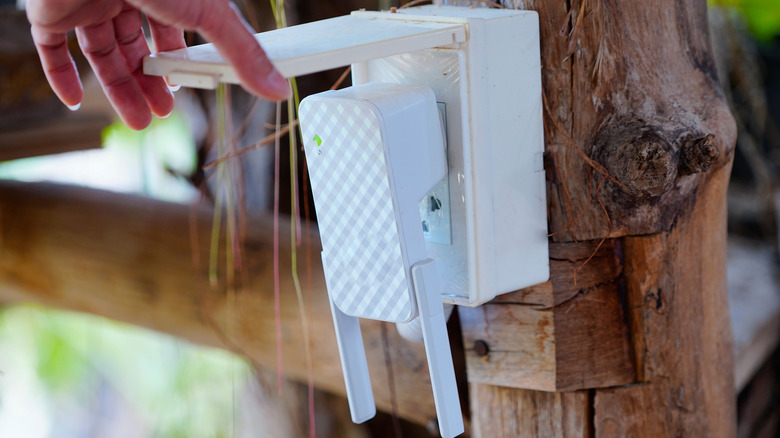How To Extend Wi-Fi Range Outside Your Home
Wi-Fi has become a way of life for most of us, allowing us to connect our devices to the internet without being tethered to cables or fixed locations. As convenient as Wi-Fi is, it has its limitations. That's why many of us are always looking for ways to maximize our Wi-Fi signal; after all, what's the point of going wireless if we have to be confined to a single room or small part of our homes for it to work? While most of us don't have many problems with getting our Wi-Fi to work throughout our homes, if you're lucky enough to have a porch or a backyard, you may have noticed that when you step outside, your Wi-Fi signal becomes weaker or disappears altogether.
That can be a problem if you want to do things like stream movies to the portable projector you've set up in your yard or get some work done on your laptop while spending some time outdoors. The good news is that with the right equipment and strategies, you can extend your Wi-Fi to locations outside the walls of your home, like your patio, garage, backyard, and garden. Once you do, you'll be able to connect to the internet wirelessly without dealing with buffering, lag, a weak signal, or no signal at all.
Optimize router placement and upgrade equipment
Depending on the size of your home and how far you want to extend your WI-Fi signal outdoors, moving your router to a better location is often enough to get a good signal outdoors. For example, if you live in an apartment or a condo with a patio, placing your router near a window or exterior wall facing the patio could help it reach outdoor areas. While it may be tempting to hide your router behind furniture or in a cabinet in your entertainment system, doing so can weaken the Wi-Fi signal inside and outside your home.
Positioning your router up high can also help by preventing barriers like walls and trees from blocking its signal. You should also keep it away from heat sources and appliances like microwaves and large electronics. Keep in mind that moving your router closer to a window might negatively impact the Wi-Fi reception in other parts of your home. However, if you live in a small space, this shouldn't be a problem. Just be prepared for some trial and error as you try to find the best place to put your router.
Upgrading your router to one with multiple antennas, MU-MIMO technology, and dual-band capability (2.4 GHz and 5 GHz) can also extend your Wi-Fi range, improving its coverage both indoors and outdoors. Many Wi-Fi routers that won't break the bank come with these features. You should also make sure your router's firmware is up to date so you don't miss out on performance upgrades or new features that might boost signal strength and stability.
Wi-Fi extenders, outdoor access points, and mesh networks
Sometimes, moving your router closer to your patio or backyard won't be enough to get a signal strong enough to use your Wi-Fi outdoors. That's when it's time to consider options that'll allow you to extend your Wi-Fi beyond the interior of your home. Wi-Fi extenders, also known as wireless access points or wireless repeaters, are a good starting point. These devices can help your home Wi-Fi network work at top performance, are the most affordable option for extending your Wi-Fi range, and are easy to use right out of the box. They work by capturing your existing signal and rebroadcasting it to cover a larger area. Their biggest drawback is that they don't work well in large outdoor spaces and might slow your network. You can plug Wi-Fi extenders into an outdoor outlet, but you'll have to bring them back inside when you've finished using them.
If you need to extend your Wi-Fi over a larger area, you can consider an outdoor access point Wi-Fi extender. These extenders are weatherproof and dust-resistant, so they can be left outside throughout the year. Alternatively, if you have a large property, a mesh Wi-FI network is often the best solution. Mesh systems consist of multiple nodes that work together to cover large areas without any drop in signal strength. They do cost more than the other options but make up for it with their reliability, scalability, and ability to eliminate dead zones. You'll want to do your research and choose a top-ranked Wi-Fi mesh system to make sure you get the best reliability and coverage possible.
Powerline adapters and wired solutions
Powerline adapters are another option if you need to extend your Wi-Fi network across a large outdoor area. They work with your home's electrical wiring to transmit a strong internet signal to an outdoor location like a deck or detached garage. To use a powerline adapter, all you have to do is plug one end of the adapter into an indoor outlet near your router and the other end into an outdoor outlet as close as possible to where you want to extend the Wi-Fi coverage. With powerline adapters, you get a strong connection without having to deal with running long Ethernet cables across your home.
If you don't mind dealing with cables, for ultimate stability, you can run an Ethernet cable directly from your router to an outdoor access point or a secondary router. While this method will get you the fastest and most reliable Wi-Fi connection outside of your home, you'll need to be sure you use weatherproof cables to protect the equipment from the elements.



